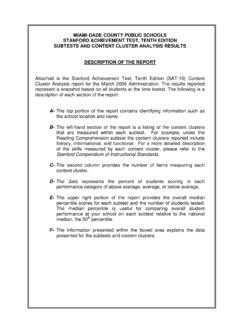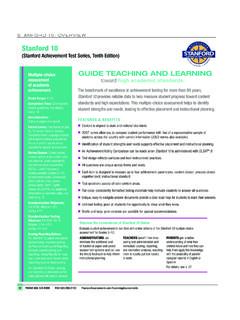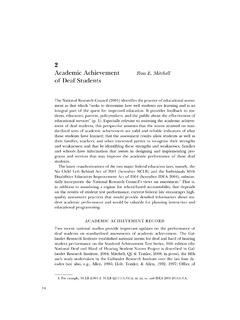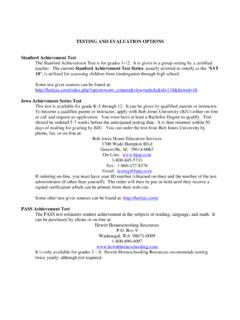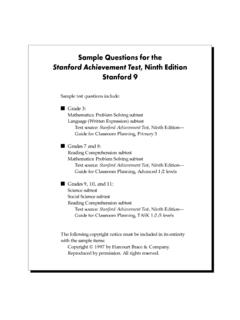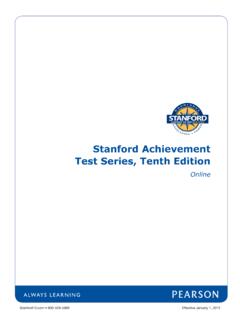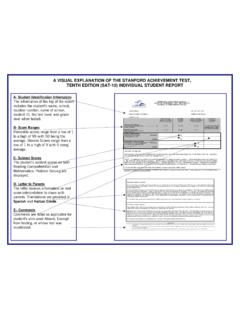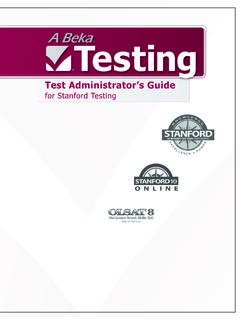Transcription of It s About Time: Stanford Achievement Test Series Tenth ...
1 It's About time : Stanford Achievement Test Series , Tenth Edition ( Stanford 10). Rationale for Untimed Testing Conditions Pearson decided to make the Stanford Achievement Test Series , Tenth Edition ( Stanford 10) an untimed test for several compelling reasons. First, 48 of the 50 states require the administration of high-stakes assessments that, rather than testing speediness, allow students to show what they know and can do when measured against criterion-referenced standards. Second, research reviewed and summarized by Tindal and Fuchs (2000) examined two factors in assessment, ability and rate of answering, and found ability to be more valid.
2 Third, Pearson conducted its own empirical study that examined timed vs. untimed testing conditions and found that the amount of time allowed to complete the test had little bearing on student performance. Finally, a focus on accommodated, standards-based assessments is supported by the implementation of the No Child Left Behind Act of 2001 (NCLB), the Individuals with Disabilities Education Act Amendments of 1997 (IDEA), and Title II of the Americans with Disabilities Act of 1990 (ADA). Pearson's Study of Timed vs. Untimed Testing Conditions Pearson's research design was planned to determine if administering Stanford 10 under both timed and untimed conditions would affect test results differentially.
3 Students taking part in the 2002 standardization of Stanford 10 were tested under untimed conditions. Separate groups of students (approximately 150 classrooms nationwide at each grade level) were tested under timed conditions. To ensure equivalent samples, students in the timed group were selected to represent the same sampling strata as the larger untimed standardization group. The variables matched included ability levels, gender, ethnicity, urban vs. rural, and disability with and without accommodations, as well as timed vs. untimed conditions. Differences in average raw scores for students tested under timed vs.
4 Untimed conditions were very small. In the majority of cases, the differences amounted to less than one raw score point. According to Brooks (2003), students tested under untimed conditions showed improved performance through grade 6. However, students above grade 6 actually performed slightly better under timed conditions. Frequently Asked Questions Q: With an untimed test, does Pearson expect every student to finish every problem? Untimed testing conditions are intended to give all students the opportunity to respond to each problem. Even so, not all students will provide a response to every problem.
5 Q: Last year, we used the Stanford Achievement Test Series , Ninth Edition ( Stanford 9), which required a timed administration. This year we will be using Stanford 10. Is Stanford 10 a standardized test, even though it is untimed? Both Stanford 9 and Stanford 10 are standardized tests . During the 2002 standardization of Stanford 10, Pearson psychometricians analyzed student response patterns and completion rates under both timed and untimed testing conditions. The Stanford 10 Technical Data Report presents the statistical analysis of those data, which serves as a demonstration of validity.
6 Q: Is there a limit to how long the test administrator should wait for a student to finish? We recommend that you allow the student to continue with a subtest as long as he or she is productively engaged with the subtest. If students are still attempting to answer test problems, allow them to continue. Pearson includes a proposed schedule of approximate testing times in the Directions for Administering (DFA) for each level of Stanford 10. These approximate testing times, based on data obtained from the 2002 standardization of Stanford 10, are comparable to the fixed times prescribed for the Stanford 9 administration.
7 These approximate times are meant to help test administrators and planners know what to expect in terms of the time required for most students to complete the tests . Only five percent of students participating in the Stanford 10 standardization required more than 30 minutes beyond the proposed testing time for any subtest. Note that all students must complete any single subtest within the same day. Q: What are some examples of students who might need more than 30 minutes of additional testing time ? Bright students who tend to be perfectionists might need more than 30 minutes of additional testing time .
8 Please be advised that longer than an hour of extra time tends to work against this type of student they tend to change answers that are correct. Students performing in the lower quartile also may require a significant amount of additional testing time . Students using accommodations might also require additional time . For example, Braille tests take About 2-1/2. times longer than regular print tests , and scribed tests take About 2 times longer. It is certainly appropriate for a teacher to determine testing time based on professional judgment and personal knowledge of the students' needs and abilities.
9 Q: Would you articulate a policy for us to follow regarding time limits for students? No child should work on a subtest for more than 30 minutes beyond the proposed administration time published in the corresponding DFA unless it is documented, for example, in an Individual Education (IEP) plan, English language learner (ELL) plan, or 504 plan that he/she needs additional time . For instance, the DFA proposes a 25-minute approximate testing time for the Science subtest at the Primary 3 level. With the addition of 30 minutes, the student would have 55 minutes to complete the subtest.
10 Q: If just one or two students have not completed a subtest, may they be moved to another location to continue and finish? This is certainly an appropriate way to handle this situation. Q: Last year, we excluded results from a group of students who were tested under untimed conditions conditions different from those of the majority of students. This year, we will again have a group of students test separately from their classmates. Is it still OK to exclude their results even though no one will have time limits? If the only variable between the smaller group and the larger student body is testing time , you should consider including the scores of the smaller group with those of their classmates.

